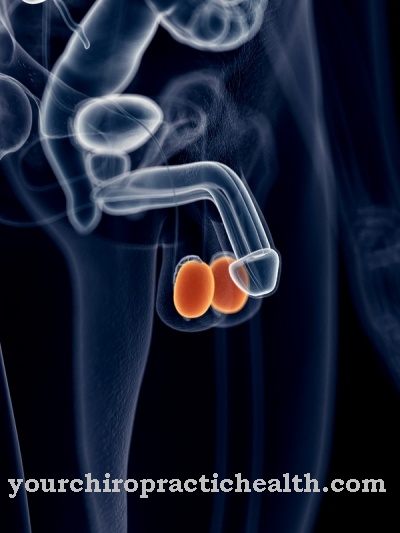As Amaurosis fugax is a term used to describe sudden blindness in one eye, which usually lasts only minutes and in exceptional cases several hours. The main symptom of the disease is that the sudden and completely painless onset of blindness regenerates itself again. Amaurosis fugax is usually caused by a temporary disturbance of blood flow to the central artery of the retina.
What is amaurosis fugax?

Amaurosis fugax is a sudden onset of blindness in one eye, which usually lasts only a few minutes and then disappears again without permanent changes or damage. In exceptional cases, the symptoms can last for up to several hours. Characteristically, one-sided blindness sets in suddenly and completely painlessly without any warning.
It disappears just as suddenly, usually after a few minutes. Short-term blindness is caused by a temporary ischemia of the retina. The very sensitive photoreceptors in the retina immediately lose their function when there is a lack of oxygen, so that the receptors (rods and cones) no longer send messages to the optic nerve.
If the oxygen deficiency is remedied within a period of at most 60 to 90 minutes, the functionality of the photoreceptors restores itself. In the event of a prolonged “power failure”, the light-sensitive cones and rods are irreversibly damaged and the affected eye is threatened with permanent blindness.
causes
The most common cause of amaurosis fugax is a temporary blockage of the central retinal artery (Arteria centralis retinae). In principle, the central retinal artery can be blocked by disease of the artery itself or by plaques or thrombi (blood clots) that have been introduced. In many cases, the obstruction of the central retinal artery is caused by a stenosis of the carotid artery (internal carotid artery).
The internal carotid artery branches off from the carotid artery, as the carotid artery is also called, and supplies the eyes, among other things. When the carotid artery is infected with arteriosclerosis, so-called plaques form, fragments of which can be detached and transported to the central artery of the retina. Here they trigger a temporary shift so that the photoreceptors in the retina are temporarily no longer supplied with oxygen.
Amaurosis fugax can also be caused by entrained thrombi, which are responsible for a temporary blockage or embolism in the central retinal artery. If the central retinal artery itself is affected, it is usually the autoimmune disease temporal arteritis, in which the immune system stimulates the formation of giant epithelial cells.
You can find your medication here
➔ Medicines for visual disturbances and eye complaintsSymptoms, ailments & signs
The main complaint, which also serves as the main symptom of amaurosis fugax, is sudden unilateral blindness, which is completely painless and usually disappears on its own after a few minutes. Typically, there are also no previous symptoms that could be interpreted as warning signs of the coming short-term blindness.
However, the disease itself should be seen as a warning sign and an indication of an impending stroke, if, for example, the carotid arteries are the cause of the temporary blindness. The fragments of plaque that temporarily blocked the central retinal artery could instead be washed into the CNS, causing a stroke.
Diagnosis & course
After a short-term unilateral blindness, which indicates amaurosis fugax, an examination of the retina using an ocular fundus is recommended.
If necessary, an examination of the retinal vessels using fluorescence angiography should also be considered in order to determine the possible blockage point in the central retinal artery. If the arterial blockage is an entrained thrombus or a fragment of plaque, an ultrasound examination of the carotid arteries is recommended.
If atherosclerosis of the carotid arteries has caused amaurosis fugax, there is a high risk of stroke if the carotid arteries are not treated. The course of the disease is by definition self-limiting even without treatment. However, there is a high risk of recurrent unilateral blindness. Only when the underlying disease that caused it has been successfully treated does the risk of recurring amaurosis fugax and a stroke with unforeseeable consequences decrease.
Complications
Short-term or partial blindness in the eye indicates amaurosis fugax. The symptom arises due to impaired blood flow to the retina. If too much plaque has built up on the artery of the eye and a piece of it comes off, it can clog the central artery.
Only when the blocked blood flow is released does the effect of temporary blindness disappear. Sometimes the symptom is noticeable with a gray or black haze in front of the eye. Those affected should seek medical assistance immediately, as there are serious complications.
Amaurosis fugax is the harbinger of arteriosclerosis developing in the neck area. This increases the risk of stroke for the patient. Furthermore, there is a suspicion of high blood pressure or a latent swelling heart disease. A high cholesterol level and diabetes can also trigger the symptom and cause further problems.
Smokers in particular belong to the risk group. The circulatory disturbance in the eye can be diagnosed using magnetic resonance angiography. In addition, the patient needs regular checks of high blood pressure as well as cholesterol and blood sugar levels. An anticoagulant is given as a therapeutic measure to stimulate blood flow. As a consequence of complications, the patient temporarily turns into a hemophilia. If the eye is too tightly blocked by plaque, a surgical procedure is carried out depending on the patient's state of health.
When should you go to the doctor?
Amaurosis fugax must always be examined by a doctor. Since blindness is usually very sudden and spontaneous, most patients also suffer from panic attacks or sweating. Furthermore, it can also lead to a loss of consciousness. In this case, an emergency doctor must be notified.
Although amaurosis fugax usually goes away after a few minutes or hours, a doctor should definitely perform an examination and diagnose the cause of the disease's appearance. This can prevent a recurrence if necessary. In some cases, amaurosis fugax indicates a stroke. Urgent treatment is necessary so that the stroke can be prevented.
In the worst case, it can lead to death of the person concerned. If the short-term blindness leads to an accident, go to a hospital or call an emergency doctor. If the patient smokes, smoking should definitely be stopped or at least reduced.
Doctors & therapists in your area
Treatment & Therapy
Direct treatment of amaurosis fugax is hardly possible due to the blindness phase, which usually lasts only a few minutes. Effective therapy therefore aims to treat the underlying disease that causes it. This can be, for example, the treatment of atherosclerosis of the carotid arteries or the treatment of the autoimmune disease temporal arteritis, if the retinal arteries themselves are affected.
With regard to the treatment of arteriosclerosis, graduated therapies are available that can be used depending on the severity and the artery affected. In addition, preventive measures are often indicated that, for example, minimize the risk of thrombus formation and thus not only prevent amaurosis fugax, but also a stroke. Any occurrence of short-term unilateral blindness should be viewed as an advance warning of a stroke.
As a first consequence, a coagulation protection can be built up. The anticoagulants provide good protection against a stroke and similar problems associated with blood clots.
Outlook & forecast
In most cases, this disease only causes temporary blindness. This blindness usually disappears after a few minutes or hours and does not lead to further symptoms. However, it can also lead to panic attacks or sweating in the patient and thus significantly reduce the patient's quality of life.
In most cases, amaurosis fugax does not result in any particular pain or previous symptoms. However, the disease should definitely be examined by a doctor, as it can be associated with an increased risk of stroke. A stroke can be fatal for the person affected and should therefore be prevented in any case.
A direct treatment of this disease is usually neither possible nor necessary. The feeling comes back after a certain period of time. However, the person concerned should lead a healthy lifestyle so that a possible stroke does not continue. Drugs that significantly reduce the risk can also be used against a stroke.
You can find your medication here
➔ Medicines for visual disturbances and eye complaintsprevention
Direct preventive measures to avoid amaurosis fugax do not exist. There are, however, a number of measures that help to minimize the risk of developing arteriosclerosis. Preventive measures therefore primarily consist of building up a protection against coagulation of the blood.
This includes good blood sugar control in the case of diabetes mellitus, a sustainable lowering of blood pressure in the case of arterial hypertension and a healthy diet. It goes without saying to keep alcohol consumption and smoking as low as possible. Even moderate exercise in endurance disciplines can be understood as a preventive measure.
Aftercare
The options for follow-up care are usually very limited in amaurosis fugax. The patient is primarily dependent on treatment by a doctor in order to avoid further complications or discomfort and to treat the disease completely. Self-healing cannot occur. Since amaurosis fugax has not yet been fully researched, the options for treating this disease are also severely limited.
The affected arteries can be treated, but this does not always lead to success. In the case of amaurosis fugax, a doctor must be consulted as soon as the first symptoms appear. Only through early treatment can further complaints be avoided.
In general, a healthy lifestyle with a balanced diet also has a positive effect on the course of amaurosis fugax. This also includes sporting activities and abstaining from alcohol, tobacco or other drugs. A stroke can also promote the disease and should of course be avoided. Whether the amaurosis fugax will also reduce the life expectancy of the person affected cannot generally be predicted. It is also often useful to have contact with other people affected by the disease, as information is exchanged.
You can do that yourself
The possibilities of self-help with amaurosis fugax are very limited. Since the symptoms occur temporarily for a few minutes or hours, it is important that the person concerned remains calm and does not become hectic or busy. Everyday life must be structured in such a way that the general risk of accidents in the event of sudden blindness is minimized as far as possible.
In the case of feelings of fear or panic, it is helpful if the person concerned always takes therapeutic help. There he learns behavioral strategies that he can independently implement and use optimally in everyday life. In order to be fully prepared for all symptoms and complications, it is advisable for those affected to obtain detailed information about the disease.
It is just as helpful if he informs people from his immediate environment about the illness and the accompanying symptoms. The more stable and informed the social network, the more professionally friends, colleagues and relatives can react to the person affected and the unexpected symptoms. In this way, the feeling of helplessness is minimized as much as possible for everyone involved. In addition, the person affected can be sure that he is receiving the necessary support, as the excessive demands of the situation are also reduced.


.jpg)














.jpg)







.jpg)


